
SIX Network Partners with ABC South Korea’s Top Security Company
SIX Network is thrilled to announce our new partnership with AhnLab Blockchain Company (ABC). ABC and SIX Network are Web3
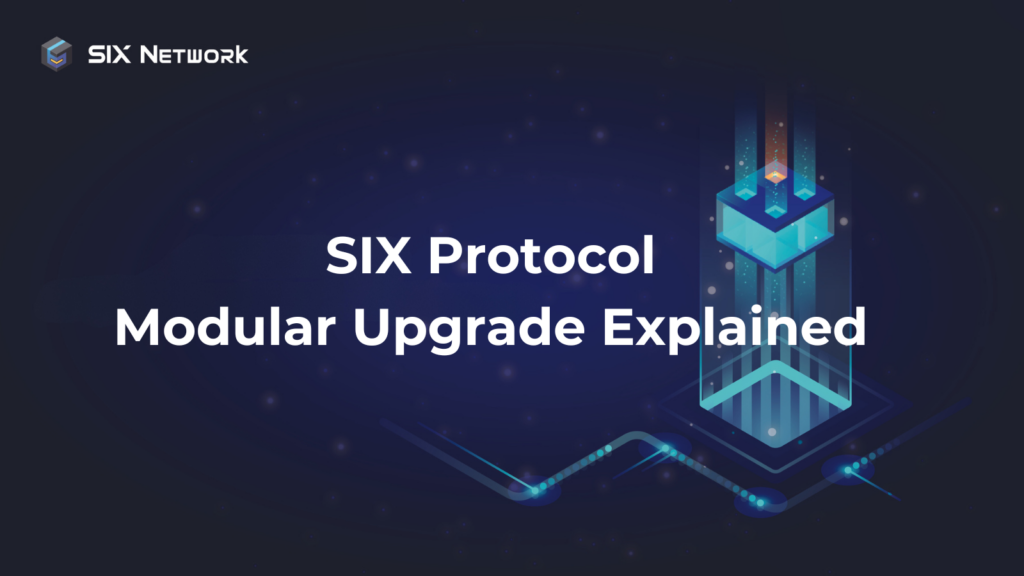
Blockchain technology is always changing, and modular blockchains are one of the exciting innovations. While traditional blockchains have changed the game in many industries, they can face some scalability limitations.
Monolithic blockchains, where all core functions happen within a single chain, often struggle to handle a large number of transactions efficiently. This is where modular blockchains come in.
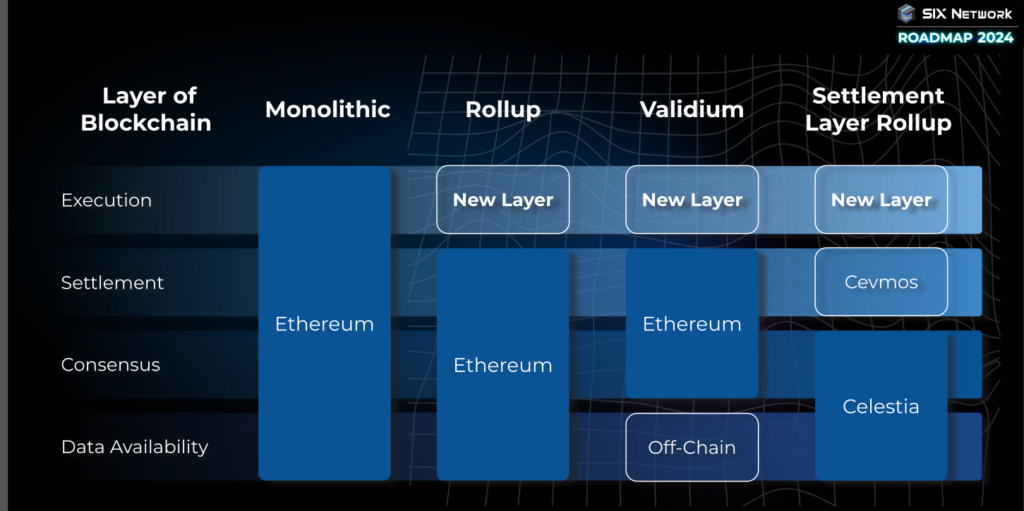
Let’s take a look with a brief overview of the differences between modular and monolithic blockchains. A blockchain, at its core, is an immutable ledger of transactions. Most blockchains are monolithic – they handle four key functions on the same layer:
• Execution: Processing transactions to update the blockchain’s state.
• Settlement: Resolving disputes, verifying transaction validity, and ensuring “finality.”
• Consensus: Reaching an agreement between validators on transaction ordering (e.g., Proof-of-Stake).
• Data availability: Ensuring transaction data is available for the entire network to view.
Modular blockchains, however, separate these functions across multiple chains. This allows for specialization and optimization.
Monolithic blockchains try to include all the transactions above in a single layer, while Modular chains focus on one part of the stack, providing customized and efficient solutions each Modular has its responsibilities to handle their task.
This distinction of Modular’s concept is important when considering the Blockchain Trilemma – the idea that a blockchain can optimize for only two out of three features: scalability, decentralization, and security.
• Scalability:
The ability to increase transactions processed (throughput) without proportionally increasing verification costs. Modular approaches solve this.
• Decentralization:
Lower hardware requirements for running full nodes mean more participation. Modular chains can have larger blocks without sacrificing decentralization because the modular blockchain is dedicated to one purpose for example one can store the data, while another could focus on optimizing RPC (Remote Procedure Call)
• Security:
Modular Blockchain has its own node set to secure its chain, creating a sovereign, independent blockchain with customization.
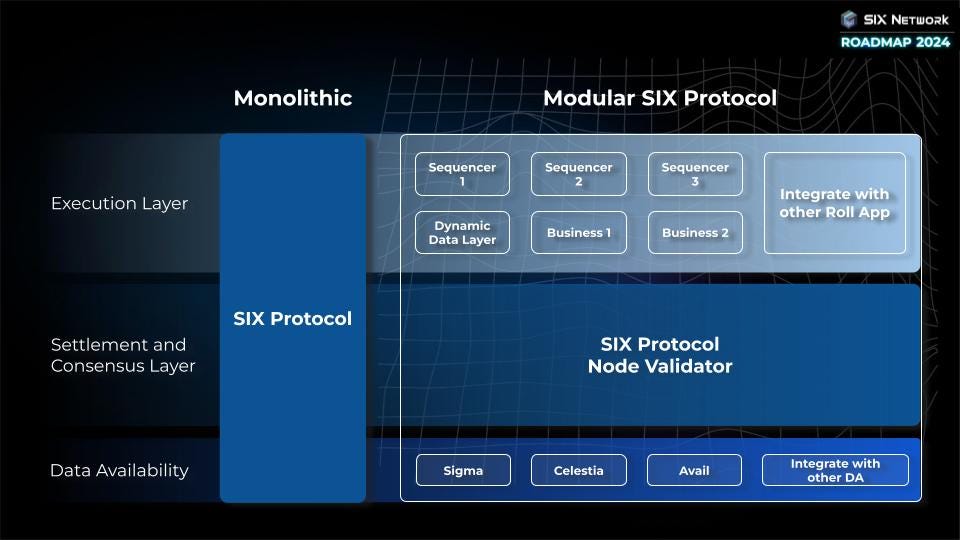
SIX Network is embracing modularity to address its growth and to increase potential use cases. This upgrade moves SIX Protocol away from a monolithic architecture toward a flexible, modular structure.
The modular blockchain concept has gained attention with projects like Celestia, Avail, and others. In this concept, execution, settlement, consensus, and data availability become separate functions. It’s like a team with specialized roles instead of one person doing everything.
SIX Network is focusing initially on the execution functions. This will allow SIX Protocol to collaborate with other modular blockchains specializing in different areas, offering more potential for global projects and scaling the SIX Protocol ecosystem.
• Enhanced Scalability: Separating functions allows for much higher transaction throughput.
• Greater Customization: Businesses and developers can choose the specific modules they need, ensuring flexibility.
• Innovation Potential: Specialization allows teams to focus on improving execution speed, optimizing data availability solutions, or strengthening consensus mechanisms.
SIX Network exemplifies the modular blockchain concept. It allows network participants to become specialized nodes, which is key to scaling SIX Network and attracting more developers and projects.
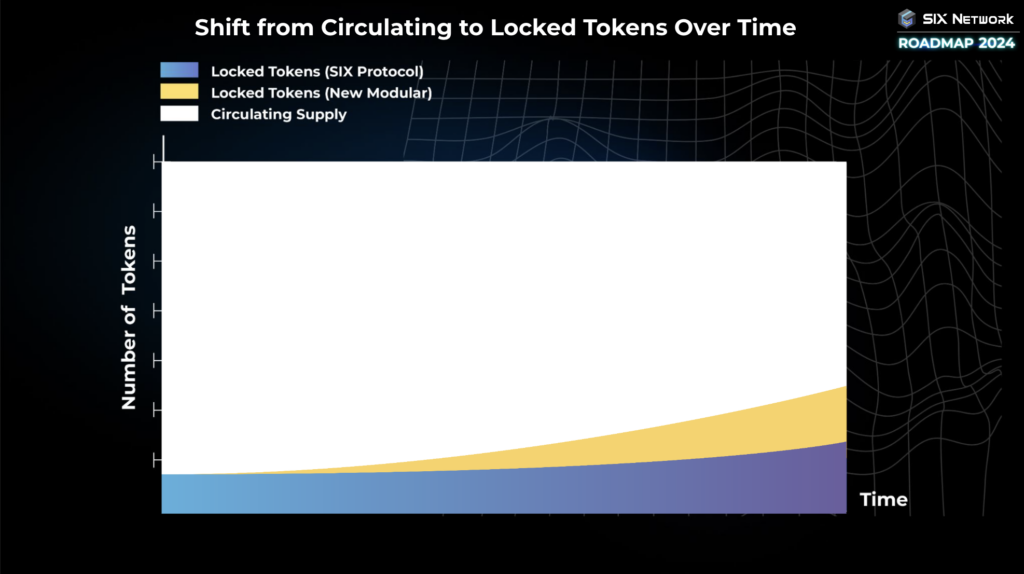
The adoption of the modular blockchain approach will significantly update the consensus system within the SIX Protocol ecosystem once the core structure is established. This will transition the SIX Protocol to a public proof of stake system, removing existing limitations and allowing more SIX holders to participate in node staking. As a result, more SIX tokens will be locked in nodes, reducing their availability on the market. The staking participants will be able to enjoy rewards from staking SIX tokens as well as get possible airdrops.
Modular blockchains represent a significant advancement, overcoming the limitations of the monolithic blockchain. This redesigned structure offers improved scalability, flexibility, and greater innovation potential. SIX Protocol is developed for this transformation and designed to adapt and become versatile solutions for various industries in the coming year.
——————————————–
Follow SIX Network
Join Discord

Experience the magic of Blockchain with SIX Network!

SIX Network is thrilled to announce our new partnership with AhnLab Blockchain Company (ABC). ABC and SIX Network are Web3

SIX Network is excited to announce our partnership with FANDOM STUDIO for the Fan-Fi project, making it easier for fans

SIX Network มีความยินดีอย่างยิ่งที่จะประกาศร่วมเป็นพาร์ทเนอร์กับ FANDOM STUDIO เพื่อพัฒนาอุตสาหกรรมสื่อและวงการบันเทิงให้เติบโตยิ่งขึ้น ผ่านนวัตกรรมบล็อกเชนจาก SIX Ecosystem การร่วมมือกันครั้งนี้เป็นการส่งเสริมธุรกิจหรือวงการบันเทิง หรือ สร้างกิจกรรมที่ทำให้แฟนคลับกับผู้ใช้งานสามารถเข้าถึงศิลปิน, ไอดอล, ผลงานเพลง และสิทธิประโยชน์อื่น ๆ จาก Fan-Token NFT ซึ่งเป็นเหรียญประจำแพลตฟอร์มที่ใช้งานเพื่อรับสิทธิพิเศษต่าง

SIX Token จะถูกลิสต์บน Bitget แพลตฟอร์มแลกเปลี่ยนคริปโตชั้นนำ ในวันที่ 29 เมษายน 2567 SIX Network บริษัทผู้ให้บริการด้าน Blockchain Solutions ได้ประกาศการลิสต์ SIX token ($SIX) ใน

SIX Token is Listing on Bitget Best Copy Trading Platform on April 29, 2024 SIX Network, a prominent player
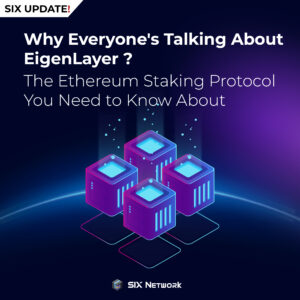
Let’s get to know Ethereum’s Next Big Thing “EigenLayer” Protocol Hottest Ecosystems. Currently! You can’t miss EigenLayer these days –
| Cookie | Duration | Description |
|---|---|---|
| cookielawinfo-checkbox-analytics | 11 months | This cookie is set by GDPR Cookie Consent plugin. The cookie is used to store the user consent for the cookies in the category "Analytics". |
| cookielawinfo-checkbox-functional | 11 months | The cookie is set by GDPR cookie consent to record the user consent for the cookies in the category "Functional". |
| cookielawinfo-checkbox-necessary | 11 months | This cookie is set by GDPR Cookie Consent plugin. The cookies is used to store the user consent for the cookies in the category "Necessary". |
| cookielawinfo-checkbox-others | 11 months | This cookie is set by GDPR Cookie Consent plugin. The cookie is used to store the user consent for the cookies in the category "Other. |
| cookielawinfo-checkbox-performance | 11 months | This cookie is set by GDPR Cookie Consent plugin. The cookie is used to store the user consent for the cookies in the category "Performance". |
| viewed_cookie_policy | 11 months | The cookie is set by the GDPR Cookie Consent plugin and is used to store whether or not user has consented to the use of cookies. It does not store any personal data. |
